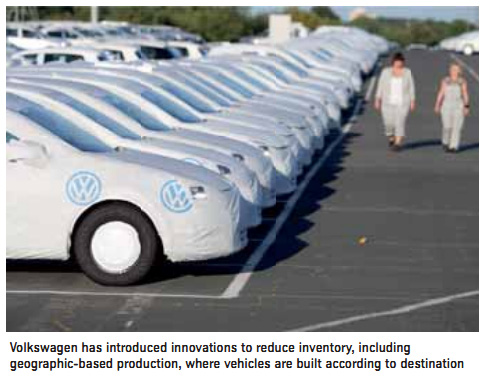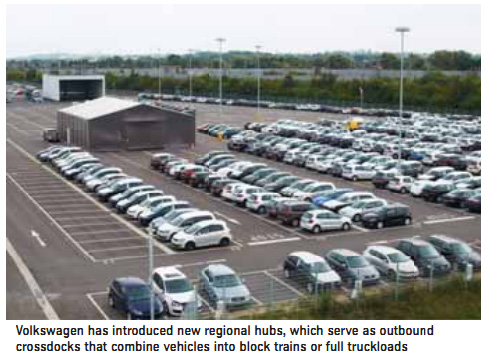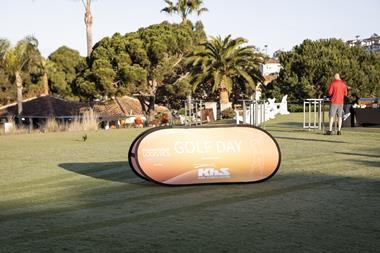
The Volkswagen Group has one of the world’s most complex distribution networks. Andrea Eck explains the advanced logistics concepts that are helping to make it faster, more precise and greener even as it grows.
The growth of the Volkswagen Group has been one of the automotive sector’s best and most often told success stories over the last five years, including its expansion in Asia, resurgence in North America and ability to outperform the European market. After topping 8m units last year, and strong growth so far in 2012, the group’s 2018 target of being the world’s number one carmaker and reaching 10m vehicles per year is now notable for being realistic as well as ambitious.
While much has understandably been made of the group’s global growth, somewhat less appreciated has been the sheer complexity and expansion of Volkswagen’s distribution network. After formally integrating Porsche earlier this year and including Volkswagen Commercial Vehicles, Scania and MAN, the group is now made up of 12 brands with 99 production locations and 240 different vehicle models globally. Volkswagen Group Logistics, the central logistics function, oversees the supply of vehicles into 150 markets.
This network requires tremendous logistics coordination. In Europe alone, the group contracts directly with 105 trucking carriers, 15 different shipping lines and eight rail providers. Last year, the company sent vehicles on 280,000 truckloads and 250,000 wagonloads.
Volkswagen’s network is made more complex by the demands of the Volkswagen production and order-to-delivery system, which assigns promised delivery dates to dealers or end-customers based on forecasted lead times. Even with the dispersion of sales points in new markets and hinterlands, the group still has the objectives of reducing lead times, inventory and emissions in the outbound supply chain. What’s more, along with the 2018 sales target, the group has committed to reducing its overall emissions by 25% (from 2010 levels) by 2018, which includes vehicle logistic operations.
“Our vehicle logistics are based on customer demands and so we are working to reduce lead times, increase flexibility and secure competitive capacity at the same time as maintaining our focus on green logistics,” says Andrea Eck, general manager outbound logistics for Volkswagen Group Logistics.
It’s a combination that seems to point in conflicting directions – more vehicles, longer distances, more locations, faster speeds, but with exact accuracy and fewer emissions. And yet, as with its sales targets, Volkswagen has developed processes and plans that are already helping it to realise these goals. For example, lead times and inventory levels have been reduced thanks to new distribution concepts, including ‘regional hubs’ for synchronised rail distribution. Emissions have been brought down thanks to an increasing use of multimodal transport.
Eck and her team lead the development of these strategies. Volkswagen Group Logistics, which includes the group’s fourth-party transport arm, Volkswagen Logistics, oversees international transport across all modes and the development and integration of outbound flows for all new plants, sales regions and models. It manages the movement of more than 5m vehicles per year, plus a growing portion of third-party business, such as used vehicles, agricultural and construction equipment and emergency service vehicles.
Eck is herself a veteran in logistics at Volkswagen. She brims with enthusiasm when discussing certain projects, such as implementation of shunting yards and regional hubs. She’s also confident and assured of the group’s chosen strategies.
Yet Eck maintains the analytical calm that you would expect from a Volkswagen manager, including a precision for data and monitoring, a strong focus on process improvement and firm, yet realistic expectations from suppliers. In her view, for example, reducing emissions will be as much about meeting regulations and harnessing new technologies as it will be about the entrepreneurship of providers willing to invest in new solutions.
Christopher Ludwig: Volkswagen has a local production strategy in growing markets but will European-produced exports still play a growing role in your distribution network?
Andrea Eck: As you say, the group’s production strategy is to produce vehicles close to its customers. The new American plant in Chattanooga, Tennessee is a case in point, as are our Chinese factories. But in our drive to reach 10m units by 2018, we cannot meet all demand locally. European and German exports have been growing and we expect that to continue.
CL: With this in mind, have you considered using export ports other than Emden?
AE: Emden is our import and export hub, but for export we already use many other European and German ports. One thing that is relatively new, however, is that we started supplying China directly from production out of Portugal using the port of Setubal. There, we have a situation similar to Emden, with a stockyard surface at the port adjacent to the plant, and so it makes sense to export the vehicles directly.
CL: Have you added any additional ports of entry in China?
AE: We use primarily three ports in China for finished vehicles: Shanghai, Xingang and Xinscha. We observe new ports all the time for vehicles and containers, which meet our high quality requirements for the ports. However, we are always in contact with our importers and joint ventures in China as we have to fulfil their requirements.
CL: What is your current import strategy for Russia?
AE: For Russia, we have a tri-modal option for maximum flexibility. Firstly, we have a compound near the Polish border in Germany where we collect Russia-bound vehicles and send them either by rail or by truck. We also have a third option to move by sea to St Petersburg. Imported volume is evenly split between all three modes.
CL:Have you considered a Black Sea approach for Russia?
AE: It’s a very interesting question and one that we’ve been monitoring for years. Currently we don’t use a Black Sea entrance because the infrastructure in the Black Sea ports would not meet our requirements.
CL: So in terms of lead times and the distribution concept it would work, but the limited infrastructure prevents it?
AE: Yes, although it is also an issue of service frequency from shipping lines. It doesn’t help us if the shipping line only goes to a port once a month. The question is also whether the group has enough volume to transport via the Black sea from Europe into Russia.
CL:Has North American growth changed the import strategy?
AE: No, we still run our own time-chartered vessels from Europe to North America, supplemented with liner services.
CL: Will the Audi factory in Mexico lead to more bundling in shipping flows, for example with South America?
AE: We’ve done bundling for years between Mexico, South American flows and now also with Chattanooga. We will continue it with our new factories in Mexico.
CL: Speaking of new locations, how involved has your team been in determining new plant locations?
AE: There is a highly standardised process for selecting plant locations at Volkswagen, with logistics and vehicle logistics included at a very early stage. We look at the overall valueadded process for all new plants and models to determine what makes sense from an outbound point of view.

CL: Can you outline the Volkswagen Group’s primary distribution strategy in Europe?
AE: Our distribution concept is always geared towards the customer and towards stable, smooth processes and less stock. If we look at the German distribution concept, vehicles which are to go somewhere in the immediate vicinity of the factory are supplied direct to retailers. In Europe we have a destination-compound structure from which we move directly to the retailers.
What we introduced last year in Europe is the so-called ‘regional hub’ structure. We bundle vehicles within the factory that have to go to a certain destination and put them onto a full train. These vehicles are then taken via shunting yards to the regional hub, where they are trucked directly to the retailers where relevant.
We first developed the concept from one of our Eastern European plants because of the increasing volumes. We are now rolling it out to all the European plants where possible.
CL: What is the regional hub structure replacing?
AE: In the past, vehicles were collected for their destinations at the factory, which meant that we had to wait until a lorry or wagon was full before dispatching the vehicles. Now we’re moving to a kind of reverse crossdock, where plant flows are consolidated before being moved to retail locations.
CL:You define these hubs in relation to inbound crossdocks. Such facilities are flexible and the location is often changed. Are the outbound consolidation points as flexible as that?
AE: I think that outbound can be as flexible as inbound insofar as crossdocks are concerned. That the location will change is a part of any dynamic planning process.
CL: Is the regional hub an extension of the NLK (new logistics concept) to outbound?
AE: The NLK has a strong focus for outbound and is not purely inbound because we are focused on the whole logistics process chain. First of all, Volkswagen’s outbound logistics are also aligned to the Volkswagen production system, where tact time, flow, pull and perfection are essential to the system. For outbound, everything is determined around the customer, so the customer actually determines the tact [time].
We have thus developed a process module that supports the NLK for outbound, speeding up the processes and stabilising the distribution flow. The regional hub is an important part of this, as is the concept of direct supply of vehicles to consolidation points after production.
CL: Can you point to any other changes aimed specifically at decreasing lead times besides the regional hubs?
AE: We’re also doing more distribution-orientated programming and product planning. This means that you bundle volume based on geographic destinations on the production line, which allows you to make full transport loads quicker. One of our brands is doing this extensively and we’re trying it in any factory where it is feasible.
CL: Are these European-grown innovations being pushed out globally?
AE:We have an exchange of standardised processes with our colleagues from the various regions. But it is up to each region to apply them or not based on local conditions.
CL: As the group’s production and sales network spreads eastward, has this led to any specific areas of new infrastructure, modes or logistics engineering?
AE: As I said, the regional hub strategy was first developed from a factory in east Europe where volumes were growing. Due to the fact that we assure important shunting yards and the increase of train transportation, we are able to implement these moves into our network. These yards are an important part or our regional hub concepts. What also plays into our cards from a group logistics perspective is the excellent location of our plants, which allows us to bundle loads from various factories and brands and then go to one central point to rearrange the volume. Eastern Europe is an important and growing part of this strategy. And in parallel we underline the high performance of our logistics service providers who support the trend of the network with their motivation.
CL: Given the disparity between markets in northern and southern Europe, have you needed to re-engineer the network and close any consolidation points in the south?
AE: We haven’t closed any consolidation points. The service providers adapted the capacity needed. But it is a kind of logistical challenge to guarantee transportation and lead times for products from the south which have to go to customers in Central or Eastern Europe.
CL: Is there more inefficiency in the network as a result?
AE:Anytime that we don’t use a full carrier or a mode of transport, it’s inefficient for providers and us. We constantly work with our providers to optimise our processes, but there is not much that we can do to improve more in this case.
Providers and entrepreneurial decisions
CL: How would you rate the current service and capacity levels from your provider base – is the market responding accordingly to growth or decline?
AE: Insofar as we can see, our providers are always adapting to market requirements. That means investments in trucks or rail, a trend we have noticed in Central and Eastern Europe. It’s an entrepreneurial decision for each provider to decide when and where to make an investment.
CL:What is your assessment of ro-ro service? Is the current capacity and speed offered by shipping lines adequate to meet Volkswagen’s requirements?
AE: The capacities are adequate. Against the background of regulations that require reduction in carbon and sulphur emissions, the shipping lines continue to slow-steam. We expect that to continue over the next years, particularly with the introduction of a 200-nautical-mile zone in North America and in the North Sea and Baltic Sea requiring low sulphur fuel.
There are many questions about how our providers will handle this. Slow steaming is one option, but there are also certain technological approaches. We’re watching carefully to see how quickly the shipping lines will move this forward.
CL: Are you concerned that the shipping lines won’t respond in time to the regulations and the result might be a 40-50% rise in bunker costs that will ultimately be passed on to customers?
AE: I think if OEMs and service providers intensively look at the concepts that will reduce emissions, operating costs will automatically come down with them.
How to reduce emissions by 2018
CL: Considering the 25% emission reduction target for 2018, in which areas of the vehicle logistics chain is Volkswagen hoping to make reductions?
AE: Around 25% of total European emissions come from transportation, including freight. It is mandatory to work on solutions to reduce emissions globally and Volkswagen is intensively working on this issue. In March this year the Volkswagen Group announced that it would make group production 25% more environmentally friendly by 2018.
For logistics activities, I see four areas to reduce emissions: the first is to produce close to the customer, already part of the group’s strategy. The second is to use each mode of transport to full capacity – concepts such as the regional hubs help to improve that. The third aspect is that we move traffic from truck to rail or water. The fourth is the use of alternative drive systems that we can use within the group or with providers, such as electric vehicles or natural gas-based equipment.
We have already started to work on those aspects and will go further in the future to reach our goals by 2018.
CL: Will carbon reduction play a specific role in future tenders and logistics engineering?
AE:Yes, our service providers can assume that this will play an important role in future tenders.
CL: Could you envision the group paying extra for logistics services that reduce emissions compared with higher emitting options?
AE: As I said, if you focus on projects that will reduce all emissions, then you will automatically bring your operating costs down. It’s again an entrepreneurial decision for a shipping line or a provider to invest in one technology versus doing something else.
CL: Is there other environmental legislation that you believe will be a challenge to outbound logistics in the coming years?
AE:We have to find solutions up front to avoid that transportation is the focus of regulations through politics. Some countries have started already. In France, for example, as of 2013, trucking companies will need to show their CO2 emissions on invoices. Such requirements could extend to other countries. It will be very important for Volkswagen to have transparent processes and data on its own emissions In shipping, from 2015 on there are also more regulations to come on sulphur emissions in the North and Baltic Sea.
CL: A few years ago Volkswagen developed a transport capacity management system. Has its use been extended?
AE: We have rolled out this system in Europe for all locations and I’m now presenting it to the regions. It has brought a lot of efficiency to the network. For one thing, we’ve extended the number of weeks included in our forecast, which benefits our providers’ abilities to plan.
CL: I understand that SEAT has trialled the use of RFID tags at its factory gate and would like to roll it out to ports. Could such a system have a group-wide application?
AE: The big problem for the industry is that when it comes to technologies like RFID, everyone is developing different standards. It would be ridiculous for one port to need different scanners and processes for each brand, for example. Ideally, we need a global standard to have the most synergies.
CL: What’s your view of how the network will develop over the coming years?
AE: I can say that the complexities of our network and the expectations for the logistics of the Volkswagen Group have increased and they will continue to do so. The group has set very ambitious targets for outbound logistics in stability, efficiency in costs and in the reductions of emissions. The consequent implementation of innovative and ecological concepts will support the group’s goals.



































